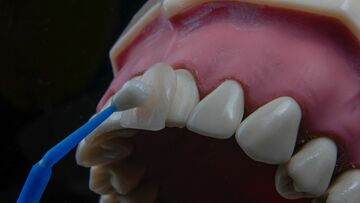
Composite bonding is growing in popularity as a quick and effective way to upgrade your smile without expensive or time-consuming treatments. But with any trending treatment, it’s important to consider the wider impact of the treatment before jumping on board the bandwagon.
Following treatment trends can be risky, particularly if the treatment isn’t the right one for you. There are also the long-term implications of the treatment that you will need to consider. In this guide, we will explore the wider implications of composite bonding treatment, including the potential benefits and downsides that you need to be aware of before you choose this treatment plan.
Read on to learn more about how composite bonding works, what it can be used to treat, and the potential pitfalls of this treatment in contrast to the potential benefits.
What is composite bonding?
Composite bonding is a cosmetic dental treatment that can be used to improve and restore your smile. It is commonly recommended to address minor imperfections such as chips, fractures and small gaps. It can also produce the appearance of straighter and whiter teeth.
Composite bonding uses a special resin that is similar to that used in white-coloured fillings. It is carefully matched to the tooth colour, or used in a whiter shade to achieve a whitening effect.
The material is applied directly to the teeth and the moulded and shaped. Once in the correct position, the dentist will cure the material with a UV light. This hardens it and makes it possible to apply the finishing touches. This could include final adjustments and then polishing the surface to create a tooth-like sheen.

What can composite bonding replace?
Composite bonding is commonly recommended as an alternative to treatments such as veneers, as it offers a cheaper and faster alternative to this treatment plan.
Composite bonding can also replace combinations of treatments such as orthodontics and teeth whitening. It’s popular with younger people as it allows them to achieve a social media-perfect smile without the long wait or the significant investment.
How long does composite bonding last?
Composite bonding is not as durable as alternatives such as crowns or veneers. It will last for around 5 years, compared to 10 – 15 years for porcelain veneers. With this in mind, it’s worth considering the lifetime value of your dental restoration.
Once the composite bonding starts to wear down, you will need to take action and invest in another treatment. This could include upgrading to veneers, replacing the composite bonding, or removing the composite bonding.
Thankfully, since the underlying tooth structure is not altered to make room for the composite bonding, removing it will always be an option.

What are the benefits of composite bonding?
These are just some of the benefits you can expect to enjoy with this treatment. The many benefits help to explain why this treatment has fast become a favourite among many patients.
Composite bonding is a fast treatment that can be completed in just one visit.
It’s minimally invasive, which means that the underlying tooth structure does not need to be changed to make space for the restoration.
It is pain-free, so you won’t need any local anaesthetic or downtime after the procedure.
It can achieve a wide range of cosmetic changes, including closing gaps, hiding chips and fractures, whitening teeth, straightening teeth and hiding thinning enamel.
This treatment is very cost-effective and much cheaper than treatments like orthodontics and veneers.
The composite resin can help to protect the underlying tooth structure, particularly in cases where the tooth is weakened from thin enamel.

What are the disadvantages of composite bonding?
While it is an effective treatment choice, there are some downsides to consider.
Composite bonding can make the teeth feel thicker, particularly when it is used to make the teeth appear straighter.
Composite bonding will not last as long as alternative methods such as veneers or crowns. After around five years, you will need to decide if you want to remove, repair or replace your composite bonding.
While this treatment does look natural, it’s not as natural-looking as methods like porcelain veneers. The teeth won’t have the same translucent quality and shine that can be achieved with veneers.
You will need to be careful about what you eat and drink and how you use your teeth. For example, you might have to be careful when biting into crusty bread and you will need to avoid habits like chewing ice or using your teeth to cut sellotape.
Your teeth will not be immune to staining. You’ll need to visit the dental hygienist for professional cleanings to maintain your bright white smile.
Composite bonding isn’t right for everyone. For example, if you grind your teeth at night, you might not be a suitable candidate for this treatment.

So, is composite bonding a good idea?
Composite bonding could be an ideal treatment choice if you are realistic about your expectations and understand what it can achieve. It isn’t a permanent solution to your aesthetic concerns, but it is an excellent choice if you want to improve your smile without the wait.
Before choosing composite bonding, you should explore all of the options available to you. Consider the lifetime value of treatments like veneers and orthodontics before choosing the right treatment for you.
If you need to transform your smile in a hurry, then composite bonding could be the ideal choice for you. Just bear in mind that you will need a long-term plan for what you will do when the composite resin begins to wear away.
You might also use composite bonding alongside other treatment options like orthodontics and teeth whitening. It doesn’t have to be the main cosmetic treatment, it can also be used to put the finishing touches on your smile. Remember that composite materials may be used for a veneer-style transformation, or to conceal minor imperfections, more like a single crown.
If you’re ready to explore your options for smile makeovers, book a consultation with our team today.
Contact us to make an appointment
Exclusive Offer
Airflow stain removal from our hygienist


What are Veneers and How Do They Work?
22.11.2023

Teeth Straightening – is it for you?
12.08.2016
Time for you perfect smile?
Book your consultation today
When visiting our practice you know you are visiting the dental professionals trained to the highest standards. You are greeted by our welcoming staff, who share the same aim, to make your visit with us as comfortable and stress free as possible.





